Christina L. Conrath
Virginia Institute of
Marine Science
PO Box 1346
Gloucester Point, VA
23062, USA
<[email protected]>
7.1 INTRODUCTION: MODES OF REPRODUCTION
7.1.1 Introduction
Several reproductive specializations are found within the elasmobranchs. All elasmobranchs fertilize internally and produce a relatively small number of large eggs. Elasmobranch fecundity generally ranges from one to two offspring produced a year up to a maximum of 300 in the whale shark (Compagno, 1990; Joung et al., 1996). Elasmobranch reproductive strategies include oviparity, aplacental viviparity and placental viviparity (Wourms, 1977). Oviparous species enclose eggs in an egg case and deposit them into the environment, where embryos develop external to the body of the mother. Embryos remain in the egg case to develop for a period ranging from less than two months to over one year (Compagno, 1990). Viviparous species retain eggs within the uteri where the embryos develop. The yolk sac of placental viviparous species interdigitates with the uterine wall to form a placenta in which nutrients from the mother are transferred to the embryo. In most species the egg envelope is retained and incorporated into the uteroplacental complex (Hamlett, Wourms and Hudson, 1985). Gestation for viviparous species ranges from less than six months to greater than two years (Compagno, 1990). Viviparous species may have either lecithotrophic or matrotrophic development. Lecithotrophic development occurs when embryos derive their nutrition solely from yolk reserves and occurs in many aplacental viviparous species. Matrotrophic development occurs when embryos supplement the yolk reserves by obtaining maternally derived nutrients during gestation and also occurs in many aplacental species and all placental viviparous species (Wourms and Lombardi, 1992). The advantage of matrotrophy may be the increase in juvenile size at birth and therefore increased survivorship of young. Another important consideration in the evolution of elasmobranch reproductive strategies is the presence or absence of uterine compartments. Uterine compartments are formed in all species with placental development and some species with aplacental development and are believed to be an important step in the evolution of placental viviparity (Otake, 1990).
7.1.2 Oviparity
Oviparity occurs in all batoids of the family Rajidae and six families and over 100 species of sharks in the orders Heterodontiformes, Orectolobiformes and Carcharhiniformes (Compagno, 1990; Compagno, 2001). In oviparous species, eggs are enclosed within an egg case and deposited in the sea. Two types of oviparity occur, extended oviparity and retained oviparity. Almost all oviparous species have extended oviparity in which large egg cases are fertilized , enclosed in an egg case, deposited and hatch after a period of up to 15 months. In this reproductive mode almost all of the embryonic development occurs within the egg case outside of the mother’s body. Retained oviparity occurs much more rarely and refers to species in which cased eggs are retained in the oviduct and development proceeds for a longer period before the eggs are released into the sea. One form of retained oviparity occurs in some scyliorhinid catsharks when multiple egg cases are retained within the oviduct before being released (Compagno, 1990; Compagno, 1988).
The egg case generally has tendrils and sticky filaments that aide in attaching the egg to some sort of structure or substrate where the eggs incubate. The egg case also hardens after being deposited to protect the embryos from predation. All oviparous chondrichthyan eggs are laid in pairs (Mellinger, 1983). Oviparous embryos tend to be relatively smaller than viviparous embryos as growth of the embryo is constrained by the amount of yolk initially present in the yolk sac (Hamlett, 1997). Compagno (1990) suggests egg-laying elasmobranchs may select appropriate substrates for egg deposition as occurs in the bullhead shark in which the female picks up the egg after it is laid and wedges it into rocks or marine vegetation. Development time within the egg case is likely dependent on external temperature. Differences in the length of the incubation period of eggs laid by female thornback rays (Raja clavata), held at different temperatures have been noted in at least two aquarium experiments (Clark 1922, Ellis and Shackley 1995).
7.1.3 Aplacental viviparity
Embryos from species with aplacental viviparous development are retained within the mother for the duration of development, but no placental connection is formed between the mother and the embryo. A wide range of developmental forms occur within this reproductive mode and Wourms (1977) separated them into three groups: those dependent entirely on yolk reserves, those which feed on other eggs or embryos and those which possess placental analogues. Animals within the first group are considered lecithotrophic as the embryo receives no extra nutrition from the mother and animals in the last two groups are considered matrotrophic as the embryo’s nutrition is supplemented with either ovulated eggs or uterine milk (histotrophe).
Aplacental yolk sacs
Embryos from species within this group are entirely dependent on yolk reserves to complete development. This type of development is the most common reproductive strategy employed by sharks. It occurs in the orders Hexanchiformes, Squaliformes, Pristiophoriformes, Squatiniformes, Rhinobatiformes, Pristiformes, Torpediniformes and some species in the orders Orectolobiformes and Carcharhiniformes (Compagno, 1990). This form of development offers protection from predators for a longer period of time than oviparous development (Hamlett, 1997).
Oophagy and adelphophagy
Oophagy occurs when embryos within the uterus hatch out of the egg capsule after a few months and then consume additional eggs which continue to be ovulated while the embryo develops. Oophagy is thought to occur in all sharks in the order Lamniformes (Gilmore, 1993; Compagno, 1990). Specific examples described within the literature include the bigeye thresher shark (Alopias superciliosus), the pelagic thresher shark (A. pelagicus), the shortfin mako shark (Isurus oxyrinchus) and the porbeagle shark (Lamna nasus) (Moreno and Moron, 1992; Liu et al., 1999; Francis and Stevens, 1999; Mollet et al., 2000). In the sand tiger shark (Carcharias taurus), the first embryo to develop in each uterus consumes all the other embryos within that uterus (adelphophagy or intrauterine cannabilism) as well as additional ovulated eggs (Gilmore, Dodrill and Linley, 1983). This type of development may facilitate the development of large embryos and may prepare the embryo for a predatory life style (Wourms, 1977). Yano (1992) found that embryos of the false catshark (Pseudotriakis microdon) also ingest yolk material from other ova but they transfer ingested yolk to an external yolk sac rather than forming the extended stomach of lamniform oophagous embryos. Female slender smooth-hounds (Gollum attenuatus) form egg capsules which contain 30–80 ova and only one ovum within each egg capsule develops. All other ova are ingested and packed to an external yolk sac (Yano, 1993). While ova are ingested by the slender smooth-hound embryo during development, this form of reproduction may, or may not, be considered oophagy as after the initial consumption of ova within the egg sac, the embryo then develops without any additional ova or maternal investment.
Placental analogues: histotrophe and trophonemata
This type of development occurs in all rays of the order Myliobatiformes. Trophonemata are long villous extensions of the uterine epithelium that secrete histotrophe or “uterine milk”which can be ingested or absorbed by the embryo. The quantity and composition of the histotrophe varies widely between species. Trophonemata envelope the embryo and may occasionally enter the embryo through the spiracles. As yolk reserves are depleted, trophonemata increase in size and release uterine secretions rich in proteins and lipids (histotroph) (Wourms, 1981). White, Platell and Potter (2001) found that trophonemata of the stingaree (Urolophus lobatus) increase in length and enter the gill, spiracles and mouths of developing embryos in the uterus about six months after ovulation when yolk reserves from the external yolk sac have been utilized. Trophonemata are also formed in the Atlantic stingray (Dasyatis sabina) and increase in length in the late stages of gestation while the developing young are bathed in histotrophe (Snelson, Williams-Hooper and Schmid, 1988). The transfer of nutrients has been found to be much more efficient in species with trophonemata than in species with a yolk sac placenta (Wourms, 1981).
7.1.4 Placental viviparity
Placental viviparity occurs when during the course of embryonic development after an initial period of reliance on yolk from a yolk sac, the yolk sac attaches to the uterine wall and forms a yolk sac placenta and the associated yolk stalk forms the umbilical cord. In most species the egg envelope is retained and incorporated into the uteroplacental complex (Hamlett, Wourms and Hudson, 1985). Thirty percent of viviparous sharks form a yolk sac placenta (Hamlett 1997). This type of reproductive development only occurs in sharks of the order Carcharhinformes (Compagno, 1990) and can occur within the same family or genus as aplacental viviparous species. The genus Mustelus includes several aplacental viviparous species such as the spotted estuary smooth-hound (M. lenticulatus), the gummy shark (M. antarcticus) and the starspotted smooth-hound (M. manazo) and several placental viviparous species such as the dusky smooth-hound (M. canis) and the spotless smooth-hound (M. griseus) (Francis and Mace, 1980; Teshima, 1981; Lenanton et al., 1990; Conrath and Musick, 2002). Wourms and Lombardi (1992) estimate the yolk sac placenta has evolved independently 11–20 times within the elasmobranchs. This has led to a large diversity in placental structure. After ovulation placental species undergo a period of dependency on yolk reserves that may last for several weeks to months before the placenta is formed. Teshima (1981) divides the placental species into two groups, those in which it forms in mid-gestation and those in which it forms soon after ovulation.
7.2 BASIC ANATOMY
7.2.1 Males
The male reproductive system is composed of the testes, genital ducts (ductus efferens, epididymis, ductus deferens and seminal vesicle), accessory glands and secondary sex organs (Figure 7.1). Male reproductive organs and tissues have been described and defined using various terminologies and this account follows the terminology of Hamlett (1999). The testes are paired structures supported by a mesorchium and in some species enveloped by the epigonal organ. A pre-germinal fold runs the length of the testis and is the origin of the spermatogenesis process. The testes are the location of spermatogenesis and also play a role in creating and secreting steroid hormones. Pratt (1988) identified three types of testes in elasmobranchs: radial, diametric and compound, defined by their pattern of seminiferous follicle origin and propagation. The epididymis is connected to the testis via the ductus efferens, which are fine tubules which cross the mesorchium at the anterior edge of the testis. Mature sperm are discharged from the testis through the ductus efferens (Wourms, 1977). The efferent ducts join the epididymis, which expands to form a long tube with complex convolutions. The epididymis is continuous with the next section of the genital duct, the ductus deferens, also known as the vas deferens or Wolffian duct. The ductus deferens is continuous with the seminal vesicle or ampulla ductus deferens. The ductus deferens and seminal vesicle function as storage areas for seminal products and in some species sperm is packaged into either spermatozeugmata or spermatophores here (Wourms, 1977). The ureter becomes entwined with the terminal portion of the seminal vesicle and both end in the anterior wall of the urogenital sinus. The urogenital sinus vents into a common cloaca by means of a single large papilla. Two accessory glands are present, Leydig glands and the alkaline gland. Leydig glands are a series of branched tubular glands that secrete seminal fluids into the epididymis and ductus deferens. The alkaline gland of batoids may be involved in sperm protection (Hamlett, 1999).
FIGURE 7.1
The male reproductive tract of a spiny dogfish (Squalus
acanthias), ep = epididymis,
dd = ductus deferens,
and sv = seminal vesicle.
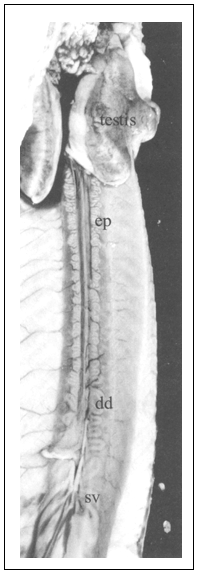
The secondary sex organs include the claspers and the associated siphon sacs. Claspers are modified regions of the pelvic fin that act as copulatory organs to transfer sperm and seminal matrix from the male to the female (Figure 7.2). All elasmobranchs have internal fertilization and possess claspers, but clasper structure varies widely. All claspers have a dorsal longitudinal groove through which semen passes to the female during mating. The clasper consists of two intermediate elements -known as the joint and beta cartilages that extend down from the metapterygium of the pelvic fin, the main stem cartilage to which two marginal cartilages are fused and four terminal cartilages, the claw, rhipidion, the distal basal and the spur. The two marginal cartilages help to form the clasper groove with a terminal end opening, the hypopyle and an anterodorsal opening, the apopyle (Compagno, 1988). A good diagram of clasper skeletal structure can be found in Compagno (2001). Most male elasmobranchs possess siphon sacs which are subcutaneous muscular, epithelium-lined bladders situated on each side of the midline between the skin and belly musculature. Each sac ends blindly anteriorly and opens into the clasper groove posteriorly through the apopyle (Gilbert and Heath, 1972). Gilbert and Heath (1972) examined the structure and function of the siphon sacs in piked dogfish (Squalus acanthias) and dusky smooth-hounds and determined that the siphon sacs’function is to hold seawater which is used to wash sperm from the clasper groove into the oviduct of the female.
FIGURE 7.2
Male and female little skates (Leucoraja erinacea),
female on the left, male on the right.
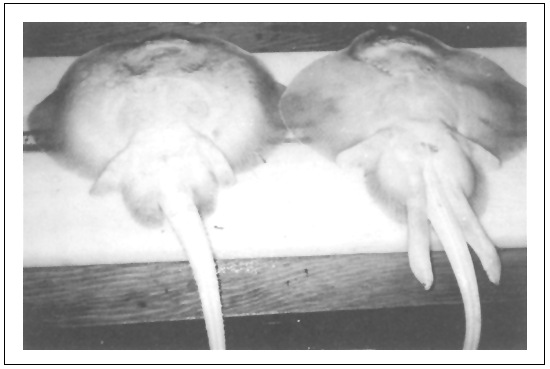
7.2.2 Females
The female reproductive system is composed of either a paired or single ovary and oviducts, which are differentiated into an ostium, the anterior oviduct, the oviducal gland, the isthmus, a dilated terminal region/uterus, a cervix and the urogenital sinus (Hamlett and Koob, 1999) (Figure 7.3). The ovary and the oviducts are in close association but are not continuous. The female reproductive tract begins as paired ovaries and oviducts, but in many adults the reproductive tract becomes asymmetrical as the animal develops. In many viviparous sharks species only the right ovary develops fully and in many ray species the right ovary and oviduct are reduced to varying degrees. The ovaries are attached to the body wall by a mesovarium (Wourms, 1977). Pratt (1988) described two types of ovaries: one found in lamniforms in which the ovary was hollow and contained within the epigonal organ, the other found in other elasmobranch species is external and borne on the flat surface of the epigonal organ or suspended directly from the mesovarium. The ovary functions in the generation of germ cells, the acquisition and accumulation of yolk and the biosynthesis and secretion of hormones. The ovary consists of oocytes, developing follicles and embedded loose connective tissue stroma. The epigonal organ is present in most species and supports the ovary or ovaries. The ostium is the anterior funnel-shaped opening of the oviduct, which functions to collect the ovulated eggs. The oviducal gland is a specialized portion of the oviduct where egg capsule and egg jelly formation occur and where fertilization may take place although it may occur in the upper oviduct (Hamlett et al., 1998). (The oviducal gland is described more completely in Section 7.6.) An isthmus may occur before the widening of the oviduct into a posterior oviducal section or a uterus and may function to isolate the contents of the uterus. The uterus in oviparous species is specialized for egg capsule formation and provides structural modifications for movement of the capsule through the uterine lumen (Koob and Hamlett, 1998). In viviparous species the uterus is highly developed and modified for retention of eggs and the developing embryos. The cervix occurs at the junction of the uterus and urogenital sinus and is constricted in this area. The uteri independently join the urogenital sinus (Hamlett and Koob, 1999).
FIGURE 7.3
The female reproductive tract dissected out of a spiny
dogfish (Squalus acanthias),
og = oviducal gland, ova=ovary, i = isthmus, e = uterine embryo, ys = embryonic
yolk sac, ut = uterus, and c = cervix.
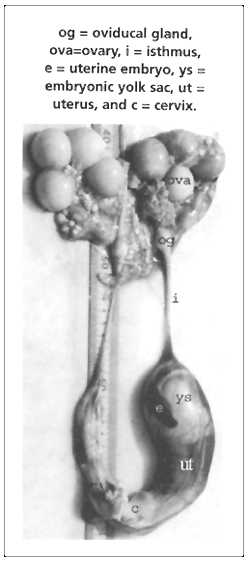
7.3 MATURITY
7.3.1 Assessing maturity
The meaning of the term “maturity”in recent elasmobranch literature ranges from defining the onset of maturation to the period of time when a female elasmobranch undergoes parturition and produces a litter of pups. Since in many elasmobranch species the period between the beginning of the maturation process until pupping can last a period of years, it is important to define the term “maturity”in an elasmobranch reproductive study. For this manual a mature animal is defined as one that is immediately capable of mating and producing viable offspring or one that has already done so. Therefore, to be considered mature, an animal must have previously mated or possess fully developed gametes and all of the secondary structures necessary for successful mating and fertilization. For female elasmobranchs that have not previously mated this requires the presence of fully developed ova in the ovaries, ready to be ovulated. For male elasmobranchs that have not previously mated this requires not only the presence of mature sperm within the reproductive tract but also the presence of fully developed claspers and siphon sacs. Maturity in sharks is determined by either observation of the reproductive tract organs or secondary sex structures or by noting the presence or absence of reproductive products within the reproductive tract.
7.3.2 Males
For male elasmobranchs to successfully mate they must have fully developed functional claspers and mature sperm ready to be transported by the claspers into the female. Therefore, male maturity can be assessed by determining if the claspers are calcified and if sperm products are found within the seminal vesicles of the reproductive tract. Clark and von Schmidt (1965) considered males mature when the clasper head (rhipidion) could be spread open, the clasper proximal to the head was rigid due to calcification of the supporting cartilage, the base of the clasper rotated easily and when the siphon sacs were fully elongated. Clasper calcification can be a simple and quick way to determine if male elasmobranchs are mature; however, maturity assessments based on calcification alone may be inaccurate as claspers may have developed before spermatogenesis is complete. Pratt (1979), in a reproductive study on blue sharks (Prionace glauca), stated that many sharks with claspers that appeared mature lacked sperm aggregations and had small ductus deferentia and were therefore still immature.
Histological evidence or direct observation will confirm the presence of sperm within the reproductive tract. Sperm products can be located and viewed by cutting a cross section of the reproductive tract, or smears of the reproductive tract can be taken, stained and viewed under a microscope to determine if viable sperm or sperm products are present. Pratt (1979) found the most accurate way to determine maturity in male blue sharks was to note the presence or absence of sperm in the ampulla ductus deferens (seminal vesicle). He found that testing for the presence of mature sperm aggregates could be done by cross-sectioning the thickest part of the kidney of the male blue shark. When the cross section was made four ducts were visible; the largest two were the seminal vesicles and the presence or absence of spermatophores in a white supportive tissue could be observed with the aid of a magnifying glass. This technique was used to assess the male maturity of smalleye hammerheads (Sphyrna tudes) and Pacific angelsharks (Squatina californica) (Natanson and Cailliet, 1986; Castro, 1989). Pratt and Tanaka (1994) stated that mature male elasmobranchs in a resting stage may not possess sperm within the ampullae of the reproductive tract but that the size and the shape of the ampullae should be a good indicator of maturity as mature males will have large ampullae. Assessments based on the presence of sperm in the reproductive tract alone may also be somewhat inaccurate as sperm may be present within the reproductive tract before the claspers are fully functional. Clark and von Schmidt (1965) found that individuals of at least two species (the blacktip shark, Carcharhinus limbatus and the tiger shark, Galeocerdo cuvier) possessed mature sperm that were produced and present in the seminal vesicles before the claspers and siphon sacs were fully developed. The best approach to determining maturity in male elasmobranchs should therefore combine an examination of clasper calcification and development with a simple field or laboratory test to determine if sperm are present within the seminal vesicles of the reproductive tract or to determine if the seminal vesicles are enlarged indicating a previous mating event.
7.3.3 Females
Female elasmobranchs are considered mature if there is evidence of a current or previous pregnancy or evidence that they will be ready to reproduce within a short period of time. For females that are not, or have not been, pregnant, maturity can be determined by assessing the condition of the ova in the ovary and the size of the oviduct. Mature females will have well developed yolky eggs in the ovary and the oviduct may start to expand and detach from the body wall. Females that have previously been pregnant will have an expanded oviduct containing expanded oviducal glands and well developed uteri. Female maturity can therefore be determined by assessing the condition of the reproductive tract and noting the presence or absence of well developed ova in the ovary, eggs or embryos within the reproductive tract, or expanded oviducts. Bass, D’Aubrey and Kistnasamy (1973) defined female sharks with distinct ova in the ovary and an expanded uteri to be mature. In doubtful cases the presence or absence of an intact hymen was used to show if the female was still an adolescent or was between pregnancies. The hymen is a circular transverse fold that separates the vagina from the cloaca; in virgin elasmobranchs the vagina is sealed by a membrane which is an extension of the hymen (Pratt, 1979). The condition of the reproductive tract has been used to determine maturity in female sandbar sharks (Carcharhinus plumbeus) and piked dogfish (Springer, 1960; Jones and Geen, 1977).
In many studies an intermediate maturing stage is identified. During this stage the oviduct begins to expand or the ova within the ovary begin to undergo vitellogenesis. In their reproductive study of piked dogfish Jones and Geen (1977) defined a maturing phase and plotted the proportion of animals in this stage versus length to determine the size at the onset of maturity. Natanson and Cailliet (1986) also define three stages of maturity for the Pacific angelshark: immature, maturing and mature based on the condition of ova in the ovary and the condition of the oviduct. Also, in many studies mature females are classified according to their stage of the reproductive cycle. Jones and Geen (1977) defined threir stages of mature females: those between pregnancies, those with candles within the uteri and those with free embryos within the uteri. Determining maturity in female elasmobranchs is largely dependent on observation and, therefore, assessing maturity will be most accurate when a large enough number of immature, maturing and mature animals can be observed.
7.3.4 Determining the size or age at maturity
7.3.4.1 Males
Size or age at maturity is usually determined by either analyzing the growth of reproductive organs relative to size or age or by quantifying the proportion of mature animals at each length or age group and determining the length at which 50% of a class is mature.
Clasper length measurements in males have been used to estimate the size at maturity because there is a known correlation between the development of secondary sex characters and the reproductive organs and maturity. Clasper length is most commonly measured from the posterior margin of the anus to the tip of the clasper (clasper inner length) or from the base of the pelvic fin to the tip of the clasper (clasper outer length) (Compagno, 1984). The length of the clasper as a proportion of the precaudal, fork or total length is plotted against the corresponding length. This usually results in a plot that shows a sharp increase in the slope for a range of lengths before leveling off. This portion of the plot with the steeper slope corresponds to the range of lengths at which the shark is becoming mature (Figure 7.4). While the most common reproductive measurement to plot against length is the clasper length in male elasmobranchs, the size or weight of other reproductive structures such as the testis and siphon sac are often used and plotted in the same way (Parsons, 1981; Teshima, 1981; and Yano, 1993).
FIGURE 7.4
The relationship between clasper length (as % total
length) and total length of dusky smooth-hounds.
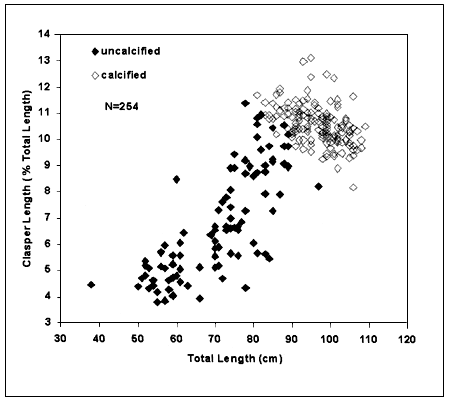
The other method commonly used to determine the size at maturity for male elasmobranchs is to use a maturity ogive. In this method, the reproductive condition of an adequate sample size of males of different sizes is first determined (Section 7.3.2). Then the proportion of mature animals in each length group is determined. These data can then be fitted witht a logistic regression and the length at the point of the curve corresponding to 50% mature is often used as an indicator of the size at which these animals mature. The logistic equation can take the following form: proportion mature at a specific length or age = 1/(1+ea+(b*length or age)), where a and b are coefficients estimated by fitting the data to the logistic curve. This equation can then be solved to determine at what length or age 50% of the population is mature (Conrath and Musick, 2002) (Figure 7.5).
FIGURE 7.5
a - Maturity ogives for total length (TL) of male and
female M. canis, b - maturity ogives for age of male and female dusky
smooth-hounds.
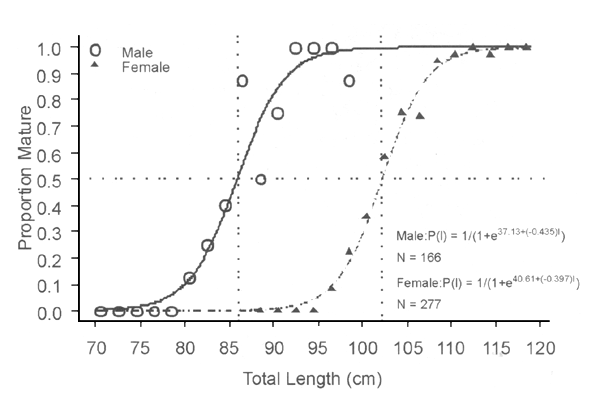 |
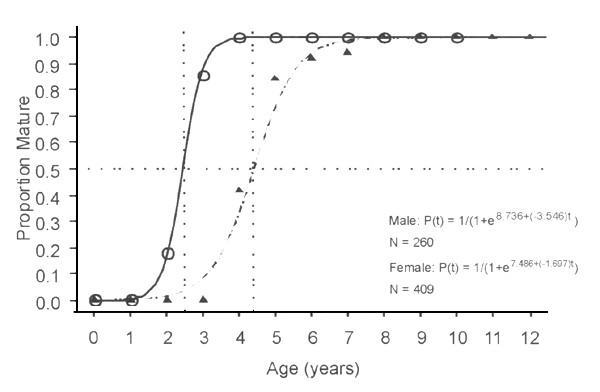 |
7.3.4.2 Females
The size of oviducal gland or other structures of the female reproductive tract is often used to assess the size at which animals become mature. The size or weight of the ovary, or the size of the oviducal gland, uterus, or other reproductive structure is often plotted against the length of the animal to determine if there is a size range at which the structure in question begins to develop quickly before growth tapers off again. As with the clasper-length versus total-length plot discussed above, the length range at which an elasmobranch population matures is determined by a change in the slope of the plot (Wass, 1973; Parsons, 1981; Castro, Ubucis and Overstrom, 1988; Yano, 1993).
As with male elasmobranchs, the other method used to determine length at maturity in female elasmobranchs is to create a maturity ogive. The same procedures and equations as explained in Section 7.3.3 are used for females (Figure 7.5) (Conrath and Musick, 2002).
7.3.5 Age at maturity versus age at first reproduction
It is important to distinguish the difference between the age or length at first maturity with the age or length of first reproduction. This distinction becomes important in demographic models. The time a fish matures is generally understood as the size or age of first mating and this needs to be distinguished from the size or age at which the animal actually produces pups. If the species being considered is oviparous or has a very short gestation time there may be only a slight or no discrepancy. However, if the animal has a gestation time of several months or longer, the delay must be accounted for in the model and the fecundity term should not be included at the size or age when the animal is first mature but at the age or size when the animal actually undergoes parturition. Dusky smooth-hound (Mustelus canis) females mature at four to five years of age and therefore in a age-based model a fecundity term would not be added until age five to six as gestation lasts nearly one year.
7.4 REPRODUCTIVE CYCLE
7.4.1 Timing
Wourms (1977) defined three types of reproductive cycles exhibited by elasmobranchs: reproduction continuously throughout the year, a prolonged annual cycle that is not well defined with one or two peaks in activity, or a well defined annual or biennial cycle. Chen, Liao and Joung (1996) found encapsulated fertilized eggs in the uteri of female blacktip sawtail catsharks (Galeus sauteri) all year round indicating this species reproduces throughout the year without a well-defined breeding season. This may be characteristic of some deep-sea elasmobranchs as this also occurs in the deep-sea black dogfish (Centroscyllium fabricii) (Yano, 1995). The small-spotted catshark (Scyliorhinus canicula) is proposed to have an extended breeding season, but peak reproductive activity occurs during the winter and spring months (Sumpter and Dodd, 1979). Dusky smooth-hounds (Mustelus canis), have a well-defined annual reproductive season with an 11 to 12 month gestation followed by ovulation of the next year class of eggs within a period of days to weeks (Conrath and Musick, 2002).
7.4.2 Mating
Determining what time of the year a species mates can be difficult and is often inferred by assuming mating occurs sometime between parturition of one year class of embryos and ovulation of the next year class of eggs to be fertilized. The timing of mating can also be inferred from viewing female specimens with mating scars. Pratt (1979) found that the skin of mature female blue sharks was twice as thick as that of male blue sharks to accommodate the biting that occurs during mating. Pratt and Carrier (2001) found that biting by males during mating seems universal among elasmobranchs and therefore during the mating season female elasmobranchs frequently bear mating marks on their bodies with the most common being tooth cuts and abrasions on the pectoral fins. They further found that in some elasmobranchs there is a sexual dimorphism of the teeth with males having teeth designed to make courtship biting more effective. Tricas and LeFeuvre (1985) proposed that biting in the whitetip reef shark (Triaenodon obesus), functions as a precopulatory releasing mechanism for females and to maintain contact during copulation. The timing of the reproductive cycle before and after mating is generally considered separately for male and female elasmobranchs.
7.4.3 Male reproductive cycle
7.4.3.1 Timing
The timing of the reproductive cycle of male elasmobranchs is generally determined by using various gonad size indices, through histological examination of the testes, or by noting the presence and amount of sperm products in the reproductive tract throughout the year. Since the contribution of the male to the reproductive effort in elasmobranchs primarily ends with mating and inseminating the female, the following two sections are primarily concerned with the timing of mating. The next two sections were not included in the previous mating section as most of the techniques listed track the reproductive condition of the male throughout the year or reproductive cycle.
7.4.3.2 Gonad size indices
A gonadosomatic index (GSI) - or some other relationship between the size of the male reproductive organs and the total size of the animal - is often used to determine when sperm and sperm products are being produced. The GSI is the testis weight expressed as a percentage of the total body weight, GSI = (testis weight/total body weight) *100. By comparing the GSI from mature males caught during various times of the year, a mating season can be estimated by assuming mating is occurring when the GSI reaches its highest value. This will correlate to the time of year when sperm production has reached its highest level. Peak GSI values may not always coincide exactly with the mating season, as sperm products must move down the reproductive tract before mating can occur and sperm may be stored in the reproductive tract for a period of time. Simpfendorfer (1992) found that the peak GSI for male Australian sharpnose sharks (Rhizoprionodon taylori) occurred approximately one month before the mating season. While a GSI can give valuable information about the timing of sperm production in male elasmobranchs, be cautious when using this data as an approximation of when mating season begins. GSI data is best used combined with other supporting data, e.g. sperm presence and quantity in the lower portions of the reproductive tract, presence of sperm products in the female or the presence of courtship wounds on the female. Stevens and Wiley (1986) defined the mating season by determining the monthly GSI of two carcharhinid shark species and also examined the quantity of sperm in the seminal vesicles, mating scars of females captured during the appropriate time of year and the mean maximum ova diameter of the females.
7.4.3.3 Histological examination of the reproductive tract
A more detailed way to track the formation of sperm in the testis over time is through histological sections of the testis. The functional unit of the testis is defined by Callard (1991) as “the germ cell clone plus associated Sertoli cells within a closed spherical unit bounded by a basement membrane”. Parsons and Grier (1992) name this unit the spermatocyst and define the sequence of development from the germinal zone to the degenerate zone, which includes zones of spermatocysts in various stages of development. Parsons and Grier (1992) define seven stages of development as do Maruska, Cowie and Tricas (1996). While these two papers differ slightly in the definition of stages, both track the spermatogenesis process from loosely organized germ cells, to spermatogonia, spermocytes, spermatids and mature spermatozoa.
To use this technique, a section is removed from the middle of the testis and preserved in 10% formalin or Bouin’s solution. The section is processed using standard histological techniques and stained with hematoxylin and eosin. The section is rinsed in a series of water washes and placed in a tissue cassette. The Bouin’s fixed tissues are rinsed with a solution of 50% ethanol (ETOH) saturated with lithium carbonate to remove soluble picrates, then rinsed in 70% ETOH. The cassettes are then placed in a tissue processor to dehydrate and infiltrate with paraffin. A rotary microtome is used to cut 5 μm thick sections of the tissue, which are then stained with hematoxylin and eosin and cover-slipped with a synthetic mounting media. The testis section is then viewed under a compound microscope and the proportion of the testis occupied by each different stage is measured along a straight-line distance across the cross section of the testis, starting from the germinal zone. Or, the number of spermotocysts occupied by each stage can be counted across the straight-line distance and compared for various times of the year. The mean proportion of the testis occupied by each stage or the mean number of spermatocysts in each stage throughout different months of the year can then be compared to determine if there is a recognizable seasonal pattern in testis development. Parsons and Grier (1992) suggest using caution with this technique as the peak testicular development may not coincide with the mating season.
Mating season has been determined for the male piked dogfish (Jones and Geen, 1977) and two smooth-hounds species, Mustelus griseus and Mustelus manazo (Teshima, 1981) by examining what percent of the ampullae contain each defined spermatogenic stage throughout the year. The timing and duration of spermatogenesis was determined for the Port Jackson shark (Heterodontus portusjacksoni) by examining the migration of the degenerative zone throughout the year (Jones and Jones, 1982).
FIGURE 7.6
Cross section of a dusky smooth-hound testis, stained with
hematoxylin and eosin.
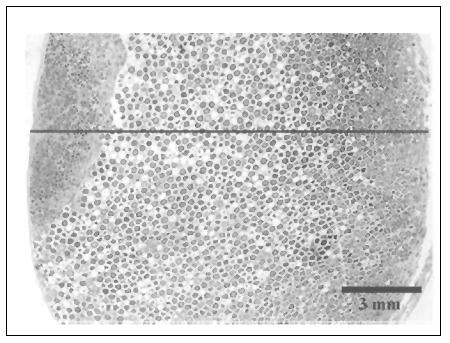
In the dusky smooth-hound the mean proportion of the testis occupied by the seven stages defined by Maruska, Cowie and Tricas (1996) was measured and compared for different months of the year to determine if there was a recognizable seasonal pattern in testis development. A cross section of the testis is shown in Figure 7.6 and the stages of the sperm development, modeled after Maruska, Cowie and Tricas (1996), are shown in Figure 7.7. Stage one consists of spermatogonia and loosely organized germ cells not yet bound by a basement membrane into a spermatocyst. During stage two a layer of spermatogonia and associated Sertoli cells divide and surround a central lumen and are bounded by a basement membrane forming the spermatocyst. In stage three the spermatogonia undergo mitosis to become primary spermatocytes, which will then undergo the first meiotic division to become secondary spermatocytes. In stage four the secondary spermatocytes have undergone the second meiotic division to become spermatids. Stage five consists of immature sperm, which are spermatids that have undergone spermiogenesis and possess a head and tail region, but individual sperm have not organized into bundles yet. During stage six these spermatozoa organize into tightly shaped packets arranged spirally along the outside of the spermatocysts. Unlike Maruska, Cowie and Tricas (1996), the seventh “degenerate”stage was classified by Conrath and Musick (2002) as the area of the testis posterior to stage six, which consists of empty spermatocysts, free spermatagonia and free spermatozoa. During September through October the majority of the testes were primarily occupied by spermatocysts in the spermatocyte stage (stage 3). During November the majority of the testes were occupied primarily by spermatocysts in the spermatid stage (stage 4). By March and continuing through May the majority of the testes were occupied by spermatocysts in the mature spermatozoa stage (stage 6). Thus mating most likely occurs sometime between the months of May and September for this species (Figure 7.8).
7.4.4 Female reproductive cycle
7.4.4.1 Ovulation cycle
In female elasmobranchs the timing of reproductive events is usually determined by direct observation of the reproductive tract, by tracking the size of ovarian eggs throughout the year (ovulation cycle) and by tracking the size of pups within the uterus throughout the year (gestation cycle). A comparison of the timing of the ovulation and gestation cycles can help determine the reproductive resting interval.
FIGURE 7.7
Sperm stages of the testis: Stages 1–7, SG =
spermatogonia, SC = spermatocytes, ST = spermatids, IS = immature sperm, MS =
mature spermatozoa, ES = empty spermatocyst, SG = spermatogonia.
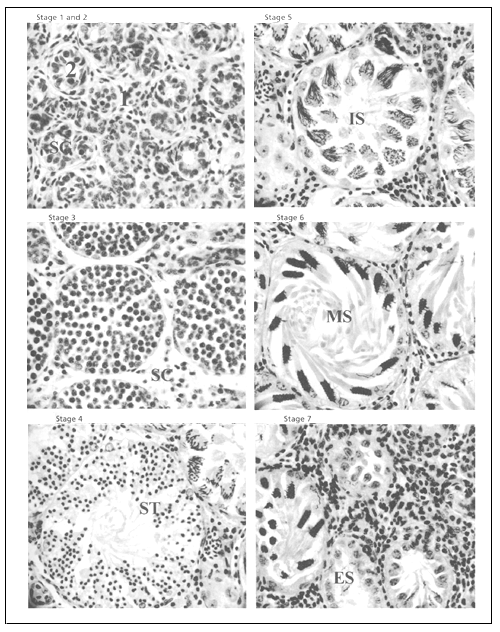
The ovulation cycle is determined by measuring the largest developing ova in the ovary and comparing their size throughout the year. Usually anywhere from two to five of the largest ova in the ovary are isolated and their diameter is measured using calipers. Then, a mean maximum ova diameter (MOD) is calculated and compared for various animals captured throughout the year. Capape, Quignard and Mellinger (1990) studied two angel shark species and plotted the diameter of oocytes and uterine ova against time to determine the timing of reproductive events. For dusky smooth-hounds the maximum ova diameter was measured and the mean MOD was calculated for each month of sampling. Ova sizes increased until May and then became much smaller by July, indicating ovulation occurs between May and July (Conrath and Musick, 2002) (Figure 7.9a).
FIGURE 7.8
The mean proportion of the testis occupied by each stage
for May through April (N=62, error bars are standard error).
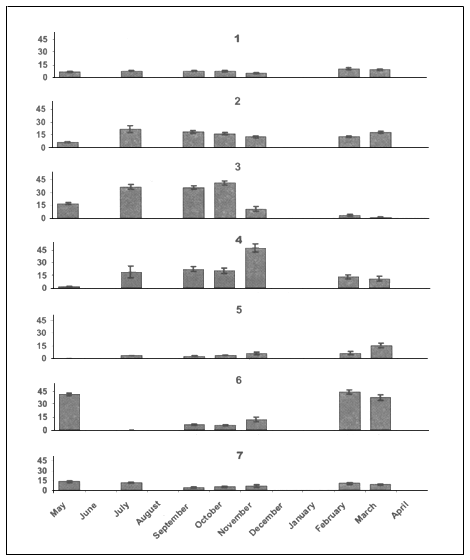
7.4.4.2 Gestation cycle and time of birth
The timing and length of gestation of viviparous species is usually determined by following the size of eggs and embryos found within the uterus through time. The length and timing of gestation has been determined by comparing the length and weight of uterine eggs and embryos throughout the year for Atlantic sharpnose sharks (Rhizoprionodon terraenovae) and dusky smooth-hounds (Parsons, 1981; Conrath and Musick, 2002) (Figure 7.9b). This can also be used to determine the size of embryos at birth and the timing of birth. If each period of the year is adequately sampled, the largest size embryos will give a minimum size estimate for size at birth. The time between the capture of females with the largest uterine embryos and of females with the smallest uterine eggs can give some indication when parturition is occurring. This approach will give a minimum estimate of size at birth but may underestimate the size at birth and not accurately reflect the timing of mating if all time periods are not sampled adequately. A more accurate way to determine the size at birth and timing of birth is to compare the size of the largest embryos found within the uterus with the size of the smallest free-living animals captured throughout the year. This approach has been taken for determining the size at birth of blue sharks (Prionace glauca) and of spotted estuary smooth-hounds (Mustelus lenticulatus) (Pratt, 1979; Francis and Mace, 1980). Females containing the largest embryos should be captured just prior to and possibly during the period of time when the smallest free living animals are captured depending on the length of the parturition period. In studies of the common guitarfish, (Rhinobatos rhinobatos) and the finetooth shark (Carcharhinus isodon), the timing of parturition has been estimated or verified by comparing the time between the capture of females with the largest embryos and the capture of the smallest free-living specimens (Abdel-Aziz, Khalil and Abdel-Maguid, 1993; Castro, 1993).
FIGURE 7.9
a - Mean maximum ova diameter (MOD), June through May. b - Mean dusky smooth-hounds pup length for May through
April (error bars are standard deviation).
| a. | 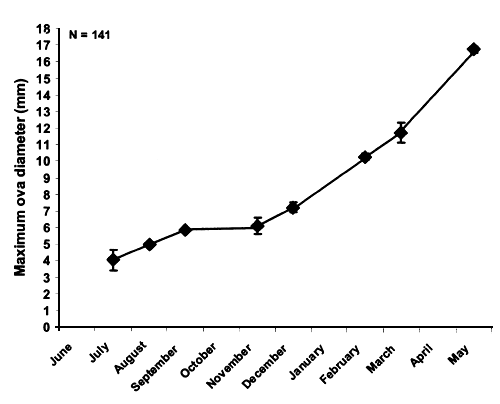 |
| b. | 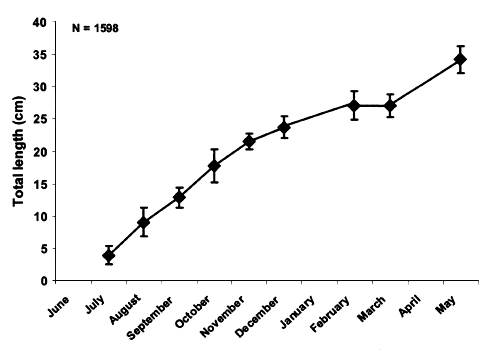 |
7.4.4.3 Reproductive interval
Another measure of interest in elasmobranch ecology is the length of the reproductive cycle. In addition to having varying lengths of gestation, many species of elasmobranchs have a resting period between pregnancies, which may last up to two years. For species with a well defined reproductive cycle, the proportion of pregnant females at any given time can be used as a preliminary indication of whether or not females undergo a resting phase between pregnancies. If all, or nearly all, the mature females are pregnant, this may indicate that there is no resting phase. Jensen et al. (2002) proposed that the porbeagle (Lamna nasus) has a yearly reproductive cycle based on the fact that all females that were sampled in the month of December were gravid. This approach must be used with caution as pregnant females may have a different migratory pattern to nonpregnant females. This appears to be the case with sand tiger sharks, (Carcharias taurus) sampled by Lucifora, Menni and Escalante (2002), who found that pregnant females occur in Brazilian waters and nonpregnant females occur in Argentinean waters. They propose a one-year resting phase for this population whose pregnant and nonpregnant mature females have different migrations.
A more accurate assessment for viviparous species, excluding perhaps oophagous species, can be made by comparing the development of ova and of embryos in the uterus in each individual. A resting cycle is usually apparent by determining if the ovulation and gestation cycles are concurrent or if they are sequential. In the dusky smooth-hound the ovulation and gestation cycles are concurrent; ova are developing at the same time that pups within the uterus are developing, with both maximum ova diameter and pup length reaching a maximum value during May (Conrath and Musick, 2002) (Figure 7.9a and 7.9b). Dusky smooth-hounds likely have a short “resting period”of days to possibly as much as one month. Simpfendorfer and Unsworth (1998) found that the whiskery shark (Furgaleus macki), has a biennial cycle with a one year resting phase by noting the presence of two groups of mature females, one pregnant with undeveloped ova in the ovary and one not pregnant with developed ova in the ovary. They propose that larger female whiskery sharks are able to produce a litter of pups yearly with no resting phase.
7.4.4.4 Reproductive cycle examples and embryonic diapause
A wide variety of reproductive cycle strategies are employed by elasmobranch species and several examples are given here to emphasize their diversity. In some populations of elasmobranchs more than one reproductive cycle a year is postulated. Two of the Dasyatis rays, D. centroura and D. marmorata, have short gestation times of only three to four months and are thought to have two or three gestation cycles per year (Capape, 1993; Capape and Zaouali, 1995). The Eastern Australian shovelnose ray (Aptychotrema rostrata) also has a short gestation of three to five months but gestation and vitellogenesis do not proceed at the same time and the gestation period is followed by a resting phase. This species only produces one litter of pups a year (Kyne and Bennett, 2002). The smalleye hammerhead (Sphyrna tudes), has a gestation of approximately 10 months and as the ovarian and gestation cycles run concurrently is postulated to have a yearly reproductive cycle (Castro, 1989). The piked dogfish has the longest gestation period known in any fish (23 months) but ovulation and gestation cycles run concurrently so female piked dogfish reproduce every two years (Jones and Geen, 1977). The blacktip shark also has a two-year reproductive cycle, but gestation only lasts 12 months, after which these sharks undergo a resting period before vitellogenesis and oogenesis resume (Castro, 1996). The tope shark (Galeorhinus galeus) has a three-year reproductive cycle with females found in one of three reproductive conditions: either (a) gravid, (b) first year nongravid with small ovarian follicles, appearing to be in a resting stage with slow vitellogensis or (c), second year nongravid with larger ovarian follicles. Gestation for this species lasts 12 months with a one-year resting phase followed by a year of vitellogenesis constituting a three-year reproductive cycle (Peres and Vooren, 1991).
Diapause for the purposes of this manual is defined as a pause in the development of fertilized eggs or young embryos within the uterus during development. This phenomenon has been documented in at least three species of elasmobranchs. Simpfendorfer (1992) found that the Australian sharpnose shark (Rhizoprionodon taylori), has embryos that undergo an approximately seven-month diapause. He proposed that this diapause may have been part of the evolution of smaller embryo size and larger litter size within this population. He also proposed that this diapause may allow embryos to be born when water temperatures are maximal and conditions for juvenile growth are optimal. Fertilized uterine eggs of the masked stingaree (Trygonoptera personata) undergo a five month period of embryonic diapause (White, Hall and Potter, 2002). The authors suggest embryonic growth for this species is delayed until water temperatures are at their highest. The bluntnose stingray (Dasyatis say) ovulates in May or June but uterine embryos do not begin to develop until the following April (Snelson, Williams-Hooper and Schmid, 1989).
7.5 FECUNDITY
The fecundity of elasmobranch species is often determined by simply counting the number of eggs and embryos within the uterus of viviparous species. Two potential difficulties arise with this method of determining fecundity. First, in some species reproductive failure occurs during gestation and the number of pups actually surviving to gestation may be considerably smaller than the initial number of ovulated eggs present in the uterus. This occurs in the stingaree species, Urolophus lobatus. White, Platell and Potter (2001) determined the mean number of embryos decreased to less than half throughout the yearly reproductive cycle and attributed this decline to embryos being aborted during pregnancy. Therefore, it may be preferable to count the number of later term embryos as this may more accurately reflect the number of pups that will survive to gestation. A second potential difficulty with simply counting uterine eggs or embryos is that many elasmobranchs will abort some eggs during the stress of capture, especially if embryos are close to parturition size. For viviparous species placental scars can be counted in the uterus to determine if embryos were aborted or to determine the fecundity of animals that are recently postpartum. Therefore, counts of embryos in the uterus may be negatively biased and this should be taken into consideration. In situations where the probability of embryos being aborted is unknown and cannot be corrected for by counting placental scars, estimates of fecundity using this method should be considered the lower limit of fecundity.
Fecundity can also be estimated by counting the number of developing ova in the ovary when uterine counts of eggs and embryos are not possible, but this is a less reliable method. Wetherbee (1996) estimated the fecundity of the southern lanternshark (Etmopterus granulosus) by counting the number of large ova in mature females. In some species uterine and ovarian fecundity have been found to be similar. Little differentiation between ovarian and uterine fecundity has been shown for populations of the shortspine spurdog (Squalus mitsukurii), two angel shark species, (Squatina squatina and S. oculata) and the tope shark (Galeorhinus galeus) (Capape, Quignard and Mellinger, 1990; Peres and Vooren, 1991; Wilson and Seki, 1994). However, in other species ovarian fecundity is notably higher than uterine fecundity indicating that some of the developing ovarian eggs will be reabsorbed. A significant difference in ovarian and uterine fecundity has been noted for populations of the finetooth shark (Carcharinus isodon) and the common guitarfish (Abdel-Aziz, 1993; Castro, 1993). While counting developing ovarian eggs will likely give a good estimate of fecundity, in many species not all ovarian eggs are ovulated and (if possible) using uterine counts of eggs and embryos will be a more accurate indicator of fecundity. However, it is important to note that using ovarian eggs to estimate fecundity will likely lead to an overestimate of fecundity and using uterine eggs or embryos to estimate fecundity may lead to an underestimate of fecundity.
Determining fecundity for oviparous species is more difficult. Fecundity, as previously mentioned, can be estimated by counting the number of developing eggs in the ovary. But many oviparous species have an extended breeding season with eggs continuing to develop throughout the year and this approach may lead to an underestimation of eggs produced. One method of estimating fecundity for oviparous species is to determine the ovulation rate and the duration of the egg laying period and to use these values to calculate the number of eggs laid by the female during the period. Sumpter and Dodd (1979) in studies of the small-spotted catshark (Scyliorhinus canicula) found an extended breeding season with peak egg laying in winter and spring but did not calculate an ovulation rate. Many estimates of fecundity and egg-laying frequency are determined by keeping animals in captivity. Chain catsharks (Scyliorhinus retifer), small-spotted catsharks and thornback rays (Raja clavata), have all been kept in captivity to determine ovulation rates and egg-laying periods. Estimated annual fecundities for these species range between 20 to 140 eggs a year with egg laying rates (of egg pairs) varying from every two days for the thornback ray to every 15.3 days for the smallspotted catshark (Holden, 1975; Mellinger, 1983; Castro, Ubucis and Overstrom, 1988; Ellis and Shackley, 1995).
FIGURE 7.10
a - The relationship between fecundity (number of pups per
litter) and total length (TL). b - The relationship between fecundity (number
of pups per litter) and age for female dusky smooth-hound.
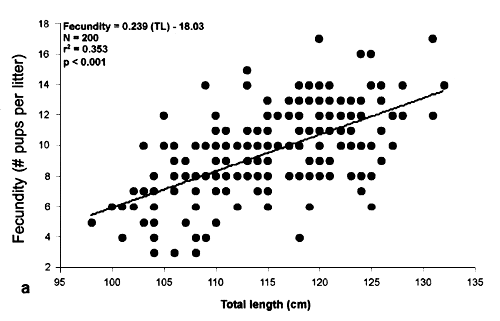 |
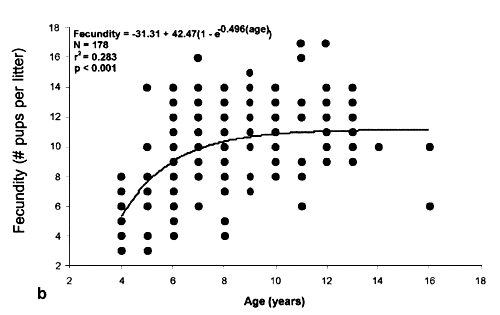 |
In many species of elasmobranchs there is a positive relationship between fecundity and the size of the female. Presumably, as a female becomes larger this increase in total length and girth results in a larger space in the body cavity to accommodate pups. A positive linear relationship is reported in many species of sharks including populations of scalloped hammerheads (Sphyrna lewini), piked dogfish and tope sharks (Chen, Leu and Joung, 1988; Hanchet, 1988; and Peres and Vooren, 1991). The relationships of fecundity and length of a species tend to have low r2 values and generally, while length is often related to fecundity, it tends to be a poor predictor of fecundity. Negative bias in fecundity estimates based on uterine counts, as previously discussed, may obscure correlations between length and fecundity. Fecundity has a significant positive relationship with both age and length in the dusky smooth-hound (Figures 7.10a and 7.10b) (the authors in this study were careful to confirm fecundity estimates in questionable cases by counting placental scars). Fecundity is more closely related to length than to age likely due to the variability in ages of larger animals. Both relationships have a low r2 value indicating the data do not fit the relationship closely and that neither age nor length are accurate predictors of fecundity for this species (Conrath and Musick, 2002).
7.6 SPERM STORAGE IN FEMALE ELASMOBRANCHS AND OVIDUCAL GLAND STRUCTURE
Sperm storage was first proposed to occur when aquarium female specimens of skates of the genus Raja continued to lay fertilized eggs after periods of separation from male specimens (Clark,1922). The storage of sperm in the oviducal gland of the female has been shown by Pratt (1993) to occur in at least nine species of sharks in the western North Atlantic. He proposes three types of fertilization to occur in elasmobranchs: (a) no storage or fertilization occurs immediately following mating, (b) short-term storage in species in which ovulation is prolonged over long periods, and (c) long-term storage for repeated fertilization.
Sperm storage is assumed to occur in species where there is a time lag between mating and ovulation and has been proposed for several species of elasmobranchs. Peres and Vooren (1991) found up to five months passes between mating and ovulation in the tope shark. Simpfendorfer and Unsworth (1998) propose a six-month period of sperm storage for the whiskery shark. White, Platell and Potter (2001) also propose a three month period of sperm storage in the lobed stingaree (Urolophus lobatus).
Sperm storage can be studied by histological examination of the oviducal gland. Hamlett et al. (1998) describe four fundamental zones of the elasmobranch oviducal gland based on the morphology of the epithelium: the proximal club zone, the papillary zone, the baffle zone and the terminal zone. The jelly coats that surround the egg are produced within the proximal club and papillary zones and various types of egg investments are produced within the baffle zone (Hamlett and Koob, 1999). To determine if sperm are present in the oviducal gland, the posterior third of the preserved oviducal gland is sectioned and stained using standard histological techniques or a sperm smear is taken from this area of the oviducal gland and stained. Pratt (1993) found that most spermatozoa are usually located in the thin walled-tubules of the lower oviducal gland. These were subsequently identified by Hamlett et al. (1998) as terminal zone tubules. Hamlett et al. (2002) noted the presence of bundled sperm throughout gestation in the terminal zone of the oviducal gland of the dusky smooth-hound. Conrath and Musick (2002) also examined the oviducal glands of dusky smooth-hounds by taking samples of the posterior third of the oviducal gland, embedding them in paraffin and sectioning and staining them with hematoxylin and eosin. The sections were then viewed with a compound microscope to determine if sperm was present in the oviducal gland. Oviducal glands contained sperm stored throughout the year with every oviducal gland examined containing some sperm. Figure 7.11 shows an oviducal gland section and a typical sperm bundle found within the terminal zone of the oviducal gland.
FIGURE 7.11
a - Cross section of the posterior third of a dusky
smooth-hound oviducal gland (S = sperm bundle, T = terminal zone, B = baffle
zone). b - Sperm bundles found within the terminal zone of the oviducal gland.
| a |
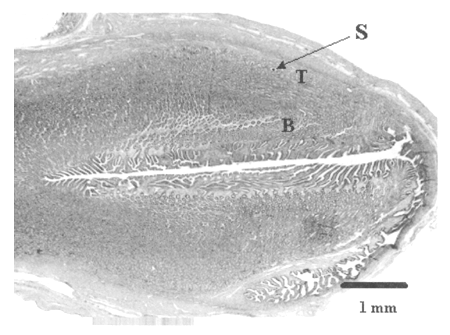 |
| b |
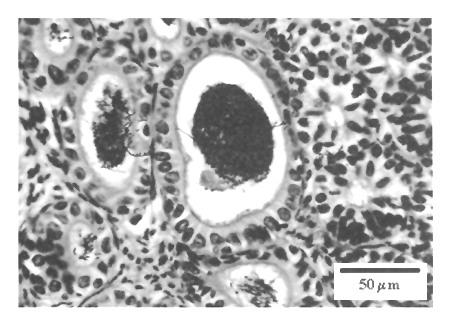 |
7.7 ADDITIONAL RESOURCES
One objective of this manual is to note web-based resources to facilitate obtaining literature on the subjects covered by the text. Unfortunately good detailed information about elasmobranch biology on the web is sparse and difficult to find. However, there is abundant, excellent literature about elasmobranch reproductive biology in the primary literature. I have therefore included a brief section on the primary literature I have found most useful in learning about elasmobranch reproductive biology. Although the literature about elasmobranch reproductive biology is quite large, it is undoubtedly incomplete and lacks sources others would find most useful. The few good web resources I located are discussed in the second section. The last paragraph includes some guidelines to assist in field data collection.
Wourms (1977) and Compagno (1990) both provide introductions to elasmobranch reproductive biology with good descriptions of the reproductive modes of elasmobranchs and provide examples. Descriptive information on general anatomy can be found in Hamlett (1999) and Hamlett and Koob (1999). Clasper structure is described in Gilbert and Heath’s (1972) work on siphon sac and clasper function of piked dogfish and dusky smooth-hounds. Information on defining maturity, reproductive cycles and fecundity are best obtained from specific species accounts. Some early descriptions of the reproductive tract are Pratt (1979) for blue shark, Parsons (1981) for Atlantic sharpnose and Teshima (1981) for Mustelus. Specific information about staging the testes is found in Parsons and Grier (1992) and Maruska, Cowie and Tricas (1996). Sperm storage and oviducal gland structure are discussed by Pratt (1993) and Hamlett (1999).
Information from the web was current as of 14 February 2003. A general description of reproductive techniques can be found at the FAO website in the Manual of Fisheries Science (Holden and Raitt 1974), http://www.fao.org/DOCREP/003/F0752E/F0752E00.htm. The Florida Museum of Natural History (http://www.flmnh.ufl.edu/) has much information about elasmobranchs on their website and a link to the IUCN Shark Specialist Group (SSG) can be found here. The SSG publishes an annual newsletter, Shark News, which can be viewed at http://www.flmnh. ufl.edu/fish/organizations/ssg/ssgdefault.html. Hamlett (1997) has a good review of elasmobranch reproductive modes published in Shark News 9 (http://www.flmnh.ufl.edu/fish/organizations/ssg/9Newsletter/shark9news1.htm). Henry Mollet has a web page with information about various species and a section on oviparous sharks, http://homepage.mac.com/mollet/. Peter Bor also has a website (http://www.rajidae.tmfweb.nl/) with photographs of various egg-laying elasmobranchs as well as good introductory material on oviparous species.
FIGURE 7.12
Field data collection sheet (PCL = pre caudal length, FL =
fork length, TL = total length, CL = clasper length, CC = notes on clasper
calcification, P/D = preserved or dissected, GW = gonad weight, GD = gonad
size, SP/A = sperm present or absent in the seminal vesicle, #DO = number of
developing ova, Bites = presence/absence of mating wounds, U. content = uterine
contents).
| Eternal | Internal | ||||||||||||||
| Species | Sex | PCL | FL | TL | WT | CL | CC | P/D | GW | GD | SP/A | #DO | Bites | Maturity | U. content |
This section is provided for the purpose of giving guidance about what data should be collected in the field for the methods discussed here. A sample data sheet (Figure7.12) is provided. In addition to standard length and weight measurements, external measurements for males should include clasper length measurements and a note on the extent of clasper calcification. Internal measurement data should include a note indicating whether reproductive tracts were dissected in the field or preserved for later examination, gonad weight, gonad size (testis weight, maximum ova diameter, uterus width, etc.), presence or absence of sperm in the seminal vesicle of males and females, the presence or absence of mating wounds, the number of developing ova in the ovary, general observations about maturity (ova size, uterine width, pregnancy, etc.) and uterine content information (number of eggs or embryos, egg and embryo width, sex and lengths of embryos, etc.). This field sheet is a general guide; each study should have previously defined objectives and a data sheet tailored to meet those requirements.
7.8 LITERATURE CITED
Abdel-Aziz, S.H., Khalil, A.N. & Abdel-Maguid, S.A. 1993. Reproductive cycle of the common guitarfish, Rhinobatos rhinobatos (Linnaeus, 1758), in Alexandria waters, Mediterranean Sea. Aust. J. Mar. Freshwater Res., 44: 507–517.
Bass, A.J., D’Aubrey, J.D. & Kistnasamy, N. 1973. Sharks of the east coast of southern Africa. I. The genus Carcharhinus (Carcharhinidae). Oceanographic Research Institute (Durban) Investigational Report No. 33. 168 pp.
Callard, G.V. 1991. Spermatogenesis. In P. Pang & M. Schreibman (ed.). Vertebrate Endocrinology: Fundamentals and Biomedical Implications, Vol. 4, Part A, pp. 303–341. Academic Press, San Diego.
Capape, C. 1993. New data on the reproductive biology of the thorny stingray, Dasyatis centroura (Pisces: Dasyatidae) from off the Tunisian coasts. Env. Biol. Fish., 38: 73–80.
Capape, C. & Zaouali, J. 1995. Reproductive biology of the marbled sting ray, Dasyatis marmorata (Steindachner, 1892) (Pisces: Dasyatidae) in Tunisian waters (Central Mediterranean). Journal of Aquariculture and Aquatic Sciences, 7: 108–119.
Capape, C. Quignard, J.P. & Mellinger, J. 1990. Reproduction and development of two angel sharks, Squatina squatina and S. oculata (Pisces: Squatinidae), off Tunisian coasts: semi-delayed vitellogenesis, lack of egg capsules, and lecithotrophy. J. Fish. Biol., 37:347–356.
Castro, J.I., 1989. The biology of the golden hammerhead, Sphyrna tudes, off Trinidad. Env. Biol. Fish., 24: 3–11.
Castro, J.I., 1993. The biology of the finetooth shark, Carcharhinus isodon. Env. Biol. Fish., 36: 219–232.
Castro, J.I., 1996. Biology of the blacktip shark, Carcharhinus limbatus, off the southeastern United States. Bull. Mar. Sci., 59: 508–522.
Castro, J.I., Ubucis, P.M. & Overstrom, N.A. 1988. The reproductive biology of the chain dogfish, Scyliorhinus retifer. Copeia, 1988: 740–746.
Chen, C.-T., Leu, T.-C. & Joung, S.-J. 1988. Notes on reproduction in the scalloped hammerhead, Sphyrna lewini, in Northeastern Taiwan waters. Fish. Bull., 86: 389–393.
Chen, C.-T., Liao, Y.-Y. & Joung, S.-J. 1996. Reproduction of the blacktip sawtail catshark, Galeus sauteri, in the waters off northeastern Taiwan. Ichthyol. Res., 43: 231–237.
Clark, R.S. 1922. Rays and Skates, Part 1. J. Mar. Biol., Assoc.,12: 577–643.
Clark, E., & Von Schmidt, K. 1965. Sharks of the central gulf coast of Florida. Bulletin of Marine Science, 15: 13–83.
Compagno, L.J.V. 1984. FAO Species Catalogue. Vol 4, Part 2: Sharks of the world, pp. 251–655 FAO, Rome.
Compagno, L.J.V. 1988. Sharks of the Order Carcharhiniformes. Princeton University Press, Princeton. 486 pp.
Compagno, L.J.V. 1990. Alternative life-history styles of cartilaginous fishes in time and space. Env. Biol. Fish., 28: 33–75.
Compagno, L.J.V. 2001. FAO Species Catalogue for Fishery Purposes. Vol 2: Sharks of the World: Bullhead, mackeral and capret sharks (Heterodontiformes, Lamniformes and Orectolobiformes). FAO, Rome. 269 pp.
Conrath, C.L. & Musick, J.A. 2002. Reproductive biology of the dusky smooth-hound, Mustelus canis, in the northwest Atlantic Ocean. Env. Biol. Fish., 64: 367–377.
Ellis, J.R. & Shackley, S.E. 1995. Observations on egg-laying in the thornback ray. J. Fish. Biol., 46: 903–904.
Francis, M.P. & Mace, J.T. 1980. Reproductive biology of Mustelus lenticulatus from Kaikoura and Nelson. New Zealand Journal of Marine and Freshwater Research, 14:303–311.
Francis, M.P. & Stevens, J.D. 1999. Reproduction, embryonic development, and growth of the porbeagle shark, Lamna nasus, in the southwest Pacific Ocean. Fish. Bull., 98:41–63.
Gilbert, P.W. & Heath, G.W. 1972. The clasper-siphon sac mechanism in Squalus acanthias and Mustelus canis. Comp. Biochem. Physiol., 42A: 97–119.
Gilmore, R.G. 1993. Reproductive biology of lamnoid sharks. Env. Biol. Fish., 38:95–114.
Gilmore, R.G., Dodrill, J.W. & Linley, P.A. 1983. Reproduction and embryonic development of the sand tiger shark, Odontaspis taurus (Rafinesque). Fish. Bull., 81:201–225.
Hamlett, W.C. 1997. Reproductive modes of elasmobranchs. Shark News 9. Internet access: http://www.flmnh.ufl.edu/fish/Organizations/SSG/9Newsletter/shark9news1.htm.
Hamlett, W.C. 1999. Male reproductive system. In W.C. Hamlett (ed.). Sharks, skates, and rays: the Biology of Elasmobranch Fishes, pp. 444–470. The Johns Hopkins University Press, Baltimore.
Hamlett, W.C. & Koob, T.J. 1999. Female reproductive system. In W.C. Hamlett (ed.). Sharks, skates, and rays: the Biology of Elasmobranch Fishes, pp. 398–433. The Johns Hopkins University Press, Baltimore.
Hamlett, W.C., Wourms, J.P. & Hudson, J.S. 1985. Ultrastructure of the full term shark yolk sac placenta. I. Morphology and cellular transport at the fetal attachment site. J.Ultrastructure Res., 91: 192–206.
Hamlett, W.C., Musick, J.A., Hysell, C.K. & Sever, D.M. 2002. Uterine epithelial-sperm interaction, endometrial cycle and sperm storage in the terminal zone of the oviducal gland in the placental smoothhound, Mustelus canis. J. Exp. Zool.,, 292: 129–144.
Hamlett, W.C., Knight, D.P., Koob, T.J., Jezior, M., Luong, T., Rozycki, T., Brunett, N.&Hysell, M.K. 1998. Survey of oviducal gland structure and function in elasmobranchs. J. Exp. Zool.,, 282: 399–420.
Hanchet, S. 1988. Reproductive biology of Squalus acanthias from the east coast, South Island, New Zealand. New Zealand Journal of Marine and Freshwater Research, 22:537–549.
Holden, M.J. 1975. The fecundity of Raja clavata in British waters. J. Cons. Int. Explor. Mer., 36: 110–118.
Holden, M.J. & Raitt, D.F.S. 1974. Manual of fisheries science, Pt. 2: Methods of resource investigation and their application. FAO Fisheries Technical Paper No. 115, revision 1. United Nations Development Programme, Food and Agriculture Organization of the United Nations, Italy. Internet access: http://www.fao.org/DOCREP/003/F0752E/F0752E00.htm.
Jensen, C.F., Natanson, L.J., Pratt, H.L., Kohler, N.E. & Campana, S.E. 2002. The reproductive biology of the porbeagle shark (Lamna nasus) in the western North Atlantic Ocean. Fish. Bull., 100: 727–738.
Jones, B.C. & Geen, G.H. 1977. Reproduction and embryonic development of spiny dogfish (Squalus acanthias) in the Strait of Georgia, British Columbia. J. Fish. Res. Board Can., 34: 1286–1292.
Jones, N., & Jones, R.C. 1982. The structure of the male genital system of the Port Jackson shark, Heterodontus portusjacksoni, with particular reference to the genital ducts. Aust. J. Zool., 30: 523–541.
Joung, S.-J., Chen, C.-T., Clark, E., Uchinda, S. & Huang, W.Y.P. 1996. The whale shark, Rhincodon typus, is a livebearer: 300 embryos found in one ‘megamamma’supreme. Env. Biol. Fish., 46: 219–223.
Koob, T. & Hamlett, W.C. 1998. Microscopic structure of the gravid uterus in Raja erinacea. J. Exp. Zool., 282: 421–437.
Kyne, P.M. & Bennett, M.B. 2002. Reproductive biology of the eastern shovelnose ray, Aptychotrema rostrata (Shaw & Nodder, 1794), from Moreton Bay, Queensland, Australia. Mar. Freshwater Res., 53: 583–589.
Lenanton, R.C.J., Heald, D.I., Platell, M., Cliff, M. & Shaw, J. 1990. Aspects of the reproductive biology of the gummy shark, Mustelus antarcticus Gunther, from waters off the south coast of Western Australia. Aust. J. Mar. Freshwater Res., 41: 807–822.
Liu, K.-M., Chen, C.-T., Liao, T.-H. & Joung, S.-J. 1999. Age, growth, and reproduction of the pelagic thresher shark, Alopias pelagicus in the Northwestern Pacific. Copeia, 1999:68–74.
Lucifora, L.O., Menni, R.C. & Escalante, A.H. 2002. Reproductive ecology and abundance of the sand tiger shark, Carcharias taurus, from the southwestern Atlantic. ICES Journal of Marine Science, 59: 553–561.
Maruska, K.P., Cowie, E.G. & Tricas, T.C. 1996. Periodic gonadal activity and protracted mating in elasmobranch fishes. J. Exp. Zool., 276: 219–232.
Mellinger, J. 1983. Egg-case diversity among dogfish, Scyliorhinus canicula (L.): a study of egg laying rate and nidamental gland secretory activity. J. Fish Biol., 22: 83–90.
Mollet, H.F., Cliff, G., Pratt, H.L. & Stevens, J.D. 2000. Reproductive biology of the female shortfin mako, Isurus oxyrinchus Rafinesque, 1810, with comments on the embryonic development of lamnoids. Fish. Bull., 98: 299–318.
Moreno, J.A. & Moron, J. 1992. Reproductive Biology of the bigeye thresher shark, Alopias superciliosus (Lowe, 1839). Aust. J. Mar. Freshwater Res., 43: 77–86.
Natanson, L.J., & Cailliet, G.M. 1986. Reproduction and development of the Pacific angel shark, Squatina californica, off Santa Barbara, California. Copeia, 1986: 987–994.
Otake, T. 1990. Classification of reproductive modes in sharks with comments on female reproductive tissues and structures. In H.L. Pratt, Jr., S.H. Gruber, & T. Taniuchi (ed.). Elasmobranchs as living resources: Advances in biology, ecology, systematics and status of the fisheries, pp. 111–130. U.S. Dep. Commer., NOAA Tech. Rep. NMFS 90.
Parsons, G.R. 1981. The reproductive biology of the Atlantic sharpnose shark, Rhizoprionodon terraenovae (Richardson). Fish. Bull., 81: 61–73.
Parsons, G.R. & Grier, H.J. 1992. Seasonal changes in shark testicular structure and spermatogenesis. J. Exp. Zool., 261: 173–184.
Peres, M.B. & Vooren, C.M. 1991. Sexual development, reproductive cycle, and fecundity of the school shark, Galeorhinus galeus off Southern Brazil. Fish. Bull., 89: 655–667.
Pratt, H.L. 1979. Reproduction in the blue shark, Prionace glauca. Fish. Bull., 77:445–470.
Pratt, H.L. 1988. Elasmobranch gonad structure: A description and survey. Copeia, 1988: 719–729.
Pratt, H.L. 1993. The storage of spermatozoa in the oviducal glands of western North Atlantic sharks. Env. Biol. Fish., 38: 139–149.
Pratt, H.L. & Carrier, J.C. 2001. A review of elasmobranch reproductive behavior with a case study on the nurse shark, Ginglymostoma cirratum. Env. Biol. Fish., 60: 157–188.
Pratt, H.L. & Tanaka, S. 1994. Sperm storage in male elasmobranchs: A description and survey. Journal of Morphology, 219: 297–308.
Simpfendorfer, C.A. 1992. Reproductive strategy of the Australian sharpnose shark, Rhizoprionodon taylori (Elasmobranchii: Carcharhinidae) from Cleveland Bay, Northern Queensland. Aust. J. Mar. Feshwater Res., 43: 67–75.
Simpfendorfer, C.A. & Unsworth, P. 1998. Reproductive biology of the whiskery shark, Furgaleus macki, off southwestern Australia. Mar. Freshwater Res., 49: 687–693.
Snelson, F.F., Williams-Hooper, S.E. & Schmid, T.H. 1988. Reproduction and ecology of the Atlantic stingray, Dasyatis sabina, in Florida coastal lagoons. Copeia, 1988:729–739.
Snelson, F.F., Williams-Hooper, S.E. & Schmid, T.H. 1989. Biology of the bluntnose stingray, Dasyatis sayi, in Florida coastal lagoons. Bull. Mar. Sci., 45: 15–25.
Springer, S. 1960. Natural history of the sandbar shark, Eulamia milberti. Fish. Bull., 61:1–38.
Stevens, J.D. & Wiley, P.D. 1986. Biology of two commercially important Carcharhinid sharks from Northern Australia. Aust. J. Mar. Freshwater Res., 37: 671–688.
Sumpter, J.P. & Dodd, J.M. 1979. The annual reproductive cycle of the female small-spotted catshark, Scyliorhinus canicula L., and its endocrine control. J. Fish Biol., 15:687–695.
Teshima, K. 1981. Studies on the reproduction of Japanese dusky smooth-houndes, Mustelus manazo and M. griseus. Journal of Shimonoseki University of Fisheries, 29:113–199.
Tricas, T.C. & Lefeuvre, E.M. 1985. Mating in the reef white-tip shark Triaenodon obesus. Mar. Biol., 84: 233–237.
Wass, R.C. 1973. Size, growth, and reproduction of the sandbar shark, Carcharhinus milberti, in Hawaii. Pacific Science, 27: 305–318.
Wetherbee, B.M. 1996. Distribution and reproduction of the southern lantern shark from New Zealand. J. Fish. Biol., 49: 1186–1196.
White, W.T., Hall, N.G. & Potter, I.C. 2002. Reproductive biology and growth during pre-and postnatal life of Trygonoptera personata and T. mucosa (Batoidea: Urolophidae). Mar. Biol., 140: 699–712.
White, W.T., Platell, M.E & Potter, I.C. 2001. Relationship between reproductive biology and age composition and growth in Urolophus lobatus (Batoidea: Urolophidae). Mar. Biol., 138: 135–147.
Wilson, C.D. & Seki, M.P. 1994. Biology and population characteristics of Squalus mitsukurii from a seamount in the central North Pacific Ocean. Fish. Bull., 92: 851–864.
Wourms, J.P. 1977. Reproduction and development in chondrichthyan fishes. Amer. Zool., 17: 379–410.
Wourms, J.P. 1981. Viviparity: The maternal-fetal relationship in fishes. Amer. Zool., 21:473–515.
Wourms, J.P. & Lombardi, J. 1992. Reflections on the evolution of piscine viviparity. Amer. Zool., 32: 276–293.
Yano, K. 1992. Comments on the reproductive mode of the false cat shark, Pseudotriakis microdon. Copeia,1992: 460–468.
Yano, K. 1993. Reproductive biology of the slender smoothhound, Gollum attenuatus, collected from New Zealand waters. Env. Biol. Fish., 38: 59–71.
Yano, K. 1995. Reproductive biology of the black dogfish, Centroscyllium fabricii, collected from waters off Western Greenland. J. Mar. Biol. Ass. U.K., 75: 285–310.